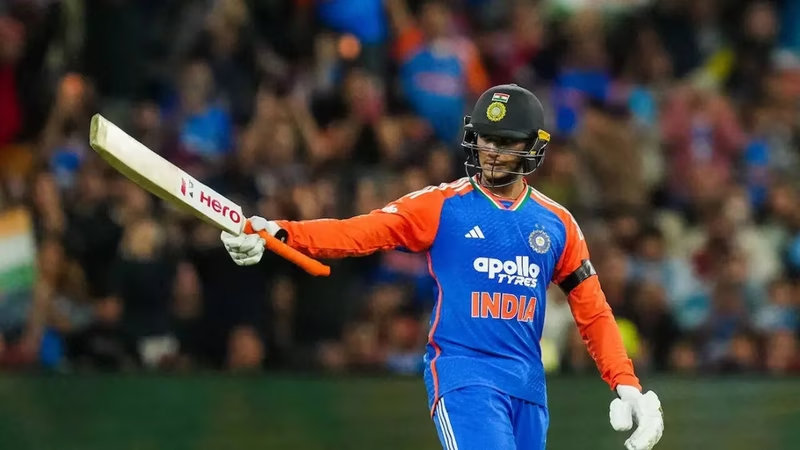Table of Contents
- A Breakthrough Not by Chance
- Abhishek Sharma: The Australia Blueprint
- Mental and Technical Preparation: Facing Pace on Bouncy Tracks
- The Role of the Indian Think-Tank
- Stats That Define His Series
- T20 World Cup 2025: The Next Frontier
- Conclusion
- Sources
When Abhishek Sharma was named Player of the Series in India’s recent T20I tour of Australia, many fans saw it as a fairy-tale debut. But the 24-year-old left-handed batter knows better. “I wasn’t lucky—I was preparing,” he revealed in a candid post-series interview . Far from a flash in the pan, his explosive performances—marked by fearless strokeplay against world-class pace—were the result of months of targeted training, mental conditioning, and a clear game plan crafted with India’s coaching staff. Now, with the T20 World Cup 2025 on the horizon, Abhishek isn’t resting on his laurels—he’s using this momentum to stake his claim for a permanent spot in the squad.
A Breakthrough Not by Chance
In a high-stakes bilateral series against Australia—a team known for its aggressive fast bowlers and bouncy pitches—Abhishek Sharma stood out not just for his runs, but for his composure. While others struggled with the extra bounce and pace, he looked at home. That wasn’t coincidence. It was calculated.
“I started working on this tour six months ago,” Abhishek explained. “I knew if I got a chance, it had to be in conditions like Australia. So I trained specifically for it.” This level of foresight is rare in young players, and it underscores a new era in Indian cricket: one where emerging talents arrive not just with talent, but with a strategic mindset.
Abhishek Sharma: The Australia Blueprint
So, what did Abhishek Sharma’s preparation actually look like? According to insiders from the National Cricket Academy (NCA), his regimen included:
- Specialized net sessions: Facing bowlers instructed to bowl short and fast on custom-built bouncy pitches.
- Video analysis: Studying his past dismissals against pace and crafting counter-strategies for specific bowlers like Starc and Cummins.
- Mental resilience drills: Working with sports psychologists to manage pressure in overseas conditions.
- Physical conditioning: Building core strength to handle the physical demands of quick footwork and pull shots.
This holistic approach allowed him to not just survive but dominate—hitting sixes over midwicket with ease and rotating strike under pressure.
Mental and Technical Preparation: Facing Pace on Bouncy Tracks
One of the biggest challenges for subcontinental batters in Australia is the short ball. Many freeze or play late, leading to edges or ducks. Abhishek’s solution? “I stopped fearing it,” he said. “I practiced the pull and hook until they became reflexes.”
Technically, he adjusted his stance—standing slightly taller with a more open chest—to get on top of the bounce quicker. He also shortened his backlift for quicker response time. These micro-adjustments, invisible to the casual viewer, made all the difference between getting bounced out and launching sixes into the Gabba stands.
Former Australian fast bowler Brett Lee noted on commentary: “He’s not just playing the ball—he’s dictating terms. That’s maturity beyond his years.”
The Role of the Indian Think-Tank
Abhishek was quick to credit India’s support staff for giving him the freedom to express himself. “The coach told me, ‘Don’t hold back. We picked you to be explosive,’” he recalled. This trust from the Indian think-tank—led by head coach Rahul Dravid and interim T20I skipper Suryakumar Yadav—was pivotal.
In an era where data-driven selection meets instinct, Abhishek’s inclusion was a bold call. But it paid off spectacularly. His ability to take on the new ball and accelerate in the powerplay filled a long-standing gap in India’s T20 lineup—a role once earmarked for the likes of KL Rahul or even Prithvi Shaw, but now firmly Abhishek’s to own.
Stats That Define His Series
Numbers don’t lie, and Abhishek’s performance spoke volumes:
- 168 runs in 3 matches at a strike rate of 157.56
- Top scorer in two of the three games
- Most sixes by an Indian batter in the series (9)
- Player of the Match in the series opener (72 off 40 balls in Perth)
These stats weren’t just impressive—they were decisive in India’s 2-1 series win .
T20 World Cup 2025: The Next Frontier
With the ICC T20 World Cup set for June 2025 in South Africa and Zimbabwe, Abhishek Sharma’s timing couldn’t be better. The tournament will feature similar fast, bouncy conditions—exactly where he’s proven he thrives.
While veterans like Rohit Sharma and Virat Kohli may return, the middle-order battle is wide open. Abhishek’s power-hitting, adaptability, and recent form make him a strong contender. As one selector anonymously told TOI, “He’s done everything asked of him. Now it’s about consistency.”
His next challenge? Performing in the IPL 2025 and domestic T20s to cement his place. But if his Australia campaign is any indication, this young gun is more than ready.
Conclusion
Abhishek Sharma’s Player of the Series award wasn’t a fluke—it was the payoff of months of disciplined preparation, psychological readiness, and unwavering self-belief. Backed by a progressive Indian coaching setup and armed with a clear game plan, he turned a tour of Australia into his personal launchpad. As the T20 World Cup looms, one thing is clear: Abhishek isn’t just a prospect anymore. He’s a problem for opposition captains—and a gift for Team India.
